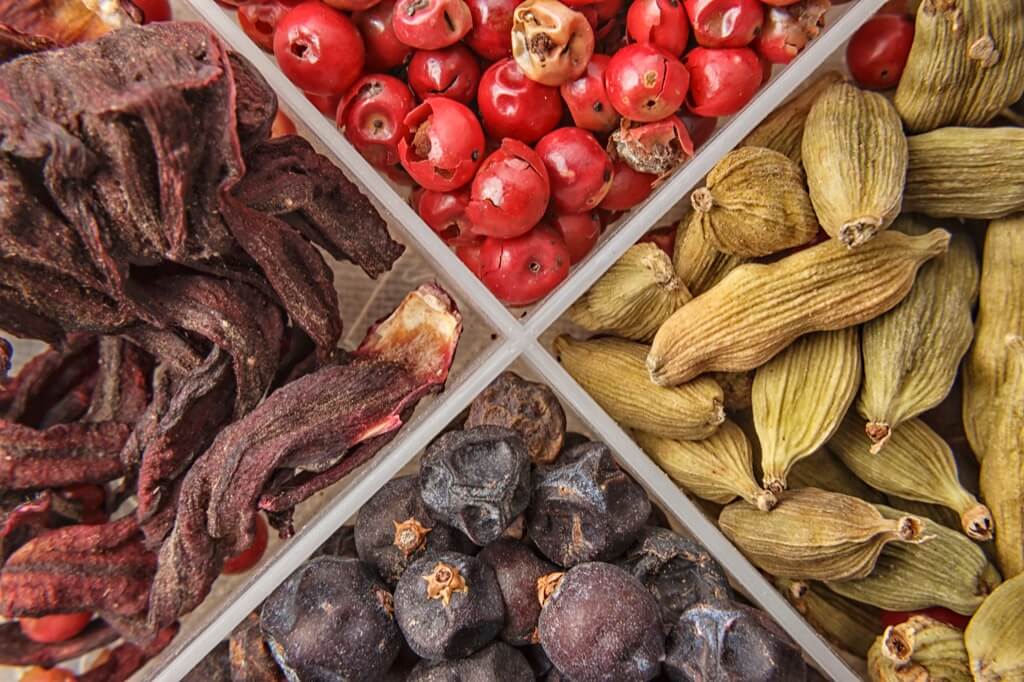You’ve probably sipped on gin a time or two, relishing the distinct juniper flavor that dances on your palate. But have you ever wondered what gives each gin its unique personality? The answer lies in the botanicals – a diverse group of plants, fruits, and herbs that are carefully chosen and infused into the spirit.
The Sensation of Terroir
When you indulge in a fine wine, you’re often told about the importance of terroir – the unique environment in which the grapes were grown. This concept is now making waves in the gin world. By sourcing local botanicals, distillers are capturing the essence of a place in every bottle. Imagine tasting the salty air of coastal regions or the rich, earthy notes of a forest floor, all encapsulated in your glass. The botanicals are no longer mere flavor enhancers; they’re storytellers, bringing tales of their homeland to your tastebuds.
The Flavors
Botanicals do more than just reflect terroir. They are the maestros of the gin symphony, dictating its tone, rhythm, and pace. A gin might incorporate peppery grains of paradise, invigorating your palate with a spicy kick. Or perhaps it uses delicate rose petals, offering a floral embrace that lingers. The possibilities are endless. As you venture deeper into the gin realm, challenge your palate. Seek out bottles that use unconventional botanicals – you might just discover your new favorite flavor profile.
A Splash of Color
The allure of gin doesn’t stop at taste. Botanicals are now painting gins in mesmerizing shades. Gone are the days when all gins were clear. Today, your glass might be tinted with the soft pink of hibiscus or the deep blue of butterfly pea flower. These natural colors aren’t just visually appealing; they’re an invitation, urging you to delve deeper into the story of the gin’s creation.
Not Everyone Agrees Though
While innovation is exciting, it’s also divisive. The use of unconventional botanicals and the inclusion of vibrant colors have stirred debates among gin enthusiasts. Purists argue that gin should remain true to its juniper roots, while modernists welcome evolution. Where do you stand? The next time you’re at a bar or a liquor store, take a moment. Engage in conversations, sample different bottles, and form your own opinion. After all, the beauty of gin lies in its diversity – both in flavors and opinions.
The Botanical Backbone

Juniper Berries
Juniper berries stand tall as the pillar of gin. It’s the core, the heart, and the soul. Its taste is unmistakably herbal, lending a piney, slightly medicinal nuance that separates gin from other spirits. Data points indicate that in the US, where craft distilleries are blossoming, the emphasis on the juniper berry’s character is paramount. This is because, for a spirit to be classified as gin in the United States, juniper must be a dominant flavor. The degree of dominance, however, is up to the distiller. They can dial up the juniper for a bold, assertive gin or tone it down to let other botanicals shine.
A Supporting Cast For Botanicals
While Juniper plays the lead role, the supporting cast of botanicals adds depth, complexity, and character to the spirit. Their presence can completely transform the gin’s personality:
- Spices: Common spices like coriander offer a citrusy, nutty flavor, while cardamom lends an exotic warmth. Anise introduces a sweet, licorice-like note, adding richness to the gin.
- Flowers: Floral botanicals like roses introduce a delicate, fragrant note, making the gin aromatic and romantic. Lavender, on the other hand, can transport you to a sun-drenched field in Provence with its sweet, herbal aroma.
- Citrus Peels: Lemon peel is often used to bring brightness and zing, elevating the gin’s freshness. Grapefruit, with its bitter-sweet profile, adds depth and contrast.
Research shows that the US gin market is witnessing an uptick in gins that emphasize local botanicals, bringing the concept of terroir – the influence of place – into the gin world. This isn’t just a nod to the wine industry; it’s an evolution of gin’s identity. Distillers in the US are keen to craft gins that echo their locale, introducing drinkers to new tastes and narratives.
The Modern Gin Frontier
In the US, there’s a noticeable trend of distillers pushing boundaries. Beyond the traditional botanicals, modern gins are venturing into uncharted territories. Think seaweed that captures the essence of the ocean, or chamomile that lulls you with its calming, apple-like aroma. Distillers are taking risks, experimenting with unconventional botanicals to craft gins that surprise and delight.
Want To Experiment With Your Gin Botanicals? Here’s How:
Choosing Your Botanicals
Start by deciding on the botanicals that resonate with your palate. As you’ve learned, juniper berries are the essential foundation for gin. However, the symphony of flavors you can build around it is boundless. Listen to your palate. Do you lean towards citrusy notes or are you enticed by floral undertones?
Sourcing the Ingredients
Opt for quality. When selecting botanicals, ensure they are fresh and organic, devoid of chemicals and pesticides. Remember, what you put in is what you get out. Your local farmers’ market or specialty store might be the treasure trove you’re looking for.
Proportions Matter
Your gin’s flavor profile is shaped by the proportion of each botanical. Start with a conservative amount, especially with potent botanicals. You can always adjust in subsequent batches, but an overpowering flavor can be hard to counterbalance.
Preparation for Infusion
Before you introduce your botanicals to the gin, ensure they’re in the best state for infusion:
- Berries and Fruits: Lightly crush them to release oils and flavors.
- Herbs and Flowers: A gentle muddle should do the trick.
- Spices: If they’re whole, give them a quick bash with a mortar and pestle.
The Infusion Process
Choose a quality neutral gin as your base. Pour it into a clean, airtight jar. Introduce your prepped botanicals to this gin. Seal the jar and let the magic happen. A typical infusion period ranges from 24 hours to a week. Check the flavor intermittently to gauge its development.
Straining and Bottling
Once your gin reaches the desired flavor profile, strain out the botanicals using a fine mesh sieve or cheesecloth. Transfer your freshly infused gin into a bottle with a tight seal. Remember, this is your creation, so label it and perhaps jot down the botanicals used for future reference.
Taste It
Pour yourself a glass, and take a moment to appreciate the aroma. As you savor, take notes on the flavor profile. Is there a botanical you’d like to enhance next time? Or perhaps one you’d dial back? This is a journey of discovery, and your notes will be invaluable in refining your gin in subsequent batches.
Safety First
Infusing gin at home is exhilarating, but always prioritize safety. Consume your infused gin within a reasonable timeframe and store it in a cool, dark place. If the gin develops an off smell or mold, it’s best to discard it.
Engage and Experiment
Don’t hesitate to experiment and iterate. Maybe next time, you could introduce a local botanical, capturing the terroir of your surroundings. The possibilities are endless, and each batch is an exemplification of your evolving palate and craftsmanship.
What’s Your Botanical Takeaway?
Gin, at its core, is a canvas for the botanical world, a spirit brought to life by the myriad flavors and aromas nature offers. The prominence of juniper as gin’s backbone is undisputed, but it’s the diverse tapestry of botanicals, from spices to flowers to citrus, that crafts its identity. As we’ve explored, these botanicals don’t just offer taste; they paint a picture, telling a story of place, of terroir.
The recent shift towards local and unique botanicals in the gin-making process is emblematic of a deeper trend: a desire to connect with our roots and surroundings. Distillers, particularly in the US, are tapping into their local environments, creating gins that are not just beverages but experiences, and journeys through specific landscapes and climates. It’s about capturing the essence of a place in a bottle.
For the at-home enthusiast, this world of botanicals offers a playground. It’s an opportunity to craft, experiment, and, most importantly, to connect – with nature, with place, and with oneself.
